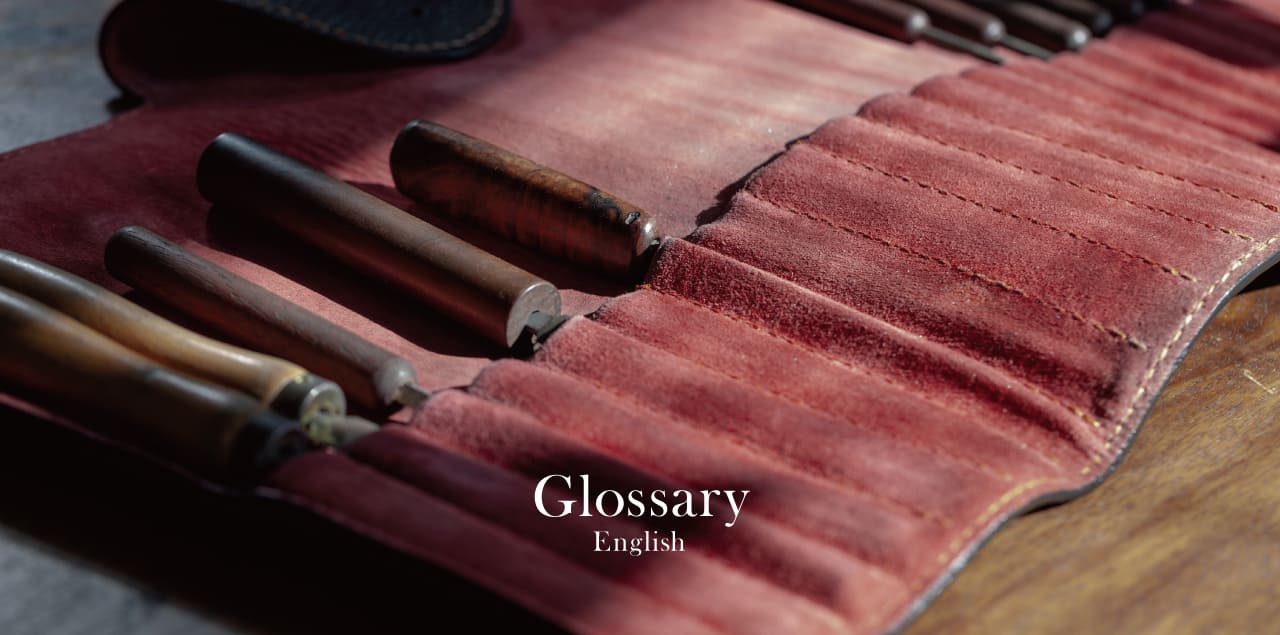Glossary
This glossary introduces traditional metalworking techniques such as zōgan (inlay) and engraving, which are woven into each piece.We invite you to explore these terms alongside our featured articles.
Zōgan (Inlay)
Zōgan is a traditional metalworking technique in which grooves are carved into the surface of a metal object and filled with different metals or materials. This method was introduced to Japan during the Kofun period and saw significant development in the Edo period. It was commonly used to decorate swords, armor, and various crafts, creating intricate and beautiful patterns. There are several types of zōgan, each allowing for unique forms of expression. Today, the technique continues to be used in jewelry and contemporary craftwork.
Takaniku Zōgan (Raised Inlay)
Takaniku zōgan is a traditional inlay technique in which designs are raised in high relief on the surface of metal, creating a sculptural effect. The process begins by carving grooves into the base metal, into which another metal is inlaid. Unlike flat inlay, the inlaid material protrudes above the surface, creating a distinct three-dimensional form. The raised metal is then finely engraved to enhance the depth and detail of the design. This technique has been used to decorate swords and fine crafts, and is especially suited for depicting motifs such as flowers and animals with lifelike realism.
Hira Zōgan (Flat Inlay)
Hira zōgan is a traditional technique in which shallow recesses are carved into the surface of a metal object, and contrasting metal pieces are inlaid to form decorative patterns. The inlay material is cut slightly thicker than the depth of the carved recess and then filed down to create a flush, smooth surface. Various methods of hira zōgan exist, and the technique can be seen in artifacts such as dishes, cylinders, and mirrors from China’s Han dynasty.
Usunikubori (Shallow-Relief Engraving)
Usunikubori is a technique used to depict designs in shallow relief, creating a subtle three-dimensional effect that lies between painting and sculpture. Unlike the deep carvings often seen in Western art, this method is characterized by smooth, raised surfaces that resemble gently pooled water. The process involves the use of specialized chisels (tagane), with careful engraving, sharpening, and polishing to achieve its delicate finish.
Shishiaibori (relief engraving (intaglio))
Shishiaibori is a metalworking technique developed during the Edo period. By carving away the surrounding area of a design, the motif is left raised, creating the appearance of a floating relief. Unlike traditional engraving, the design seems to sink gently into the surface, giving it a subtle yet dimensional presence—much like a delicate sculpture resting within the metal.
Rōnagashi Zōgan (Melted-Metal Inlay)
Rōnagashi zōgan is a traditional Japanese metalworking technique in which grooves or patterns are carved into a metal surface and then filled with molten metal to create decorative designs. The hallmark of this method is the smooth integration of the inlaid metal, resulting in elegant and fluid patterns.
NC Engraving
NC engraving (Numerical Control engraving) is a precision carving technique controlled by computer. Based on CAD data, NC machines move tools with extreme accuracy to engrave materials such as metal or wood. This method enables the creation of intricate patterns and three-dimensional designs that are difficult to achieve by hand. In this project, it is used to prepare the base grooves for inlay, complementing traditional techniques.
Laser Engraving
Laser engraving is a high-precision processing method that uses concentrated laser beams to cut, engrave, or weld materials such as metal, resin, or wood. Guided by digital design data, it allows for extremely fine detailing. In this project, laser engraving is used for carving inlay grooves and imprinting intricate patterns, harmonizing with traditional craftsmanship.

